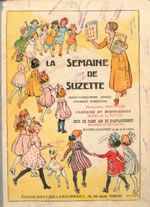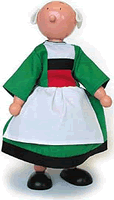Een stukje in het engels over Bécassine:
Bécassine & Bleuette
The dolls of

In 1905 Henri Gautier began the weekly magazine “La Semaine de Suzette”. As an historic reference, it was at the same time of the legal separation between the French state and the Catholic Church.
The editor set the tone before the first issue was published that “la Semaine de Suzette would be an absolute recreational diversion from religious and intelligent education”. The objective of the review was to divert, amuse, and instruct in a serial form, tell tales, illustrate histories and stories, provide games, competitions, plays, poetry, games for indoors and outdoors, sewing projects, recipes, etc. always keeping in mind the importance of civility, morality and charity.”
The magazine was published every Thursday and for the next 55 years, between 1905 and 1960 except for a six-year suspension during the war. “La Semaine de Suzette” had several hundred thousand subscribers.
A typical “Suzette” reader was between 8 and 18 years old with the vast majority between 10 and 15 who attended private school. She spoke French, lived sometimes in the colonies or if might live in a foreign country, and wished to perfect her French. She usually came from a middle class, Catholic family and was generally a child of a doctor, engineer, lawyer or diplomat….
Today, these former “Suzettes” or fans have often kept their magazines and speak nostalgically and search for these Bleuette dolls.
The dolls of “La Semaine de Suzette”
Among the dolls of “La Semaine de Suzette, two took on a life of their own.

Bécassine was born in 1905 on the drawing board at the last minute to round out the first edition of “La Semaine de Suzette”. She reappeared in later issues because of her popularity with the readers. Jacqueline Rivière first drew this small, nice and innocent girl from Brittany who was full of good intentions and energy. The editor Maurice Languereau (aka Caumery) brought her back in 1913.
The principal artist who sketched this fascinating character was Emile Joseph Porphyre Pinchon. Always in step with time, Bécassine was an aviatrix, teacher, alpinist, and from 1921, the nanny for the popular Loulotte.
From 1913 Bécassine had her own series of animated books. Pinchon and Caumery worked together as illustrator and writer for 27 albums of which the first was called “l’Enfance de Bécassine” (Bécassine’s childhood). Today Hachette-Livre/Gautier-Languereau continues to republish the original albums and adapt the text to children of all ages.
As the first heroine of animated books or comic books, Bécassine knew how to break the mold to become a timeless myth. She was able to go beyond just a comic book character. She came in all forms either of wood or stuffed wearing her costume. Her image appeared as an umbrella handle, as lamps, mechanical toys, ash trays, key rings, stationary, knick-knacks, etc. She was also the subject of a film, a well-known song by Chantal Goya and most recently a full-length animated cartoon.
Bleuette without a doubt was a cherished doll for many generations of little girls. Her ready-to-wear wardrobe was purchased directly from editor’s office or by correspondence. Her closet was increased by the girls themselves from patterns found in the magazine’s section “Nous habillons Bleuette” (Let’s dress Bleuette).
Bleuette was the mascot of the magazine and was a gift to all new subscribers in 1905. She was produced by SFBJ and increased in height from 27 cm to 29 cm. Her production ended in 1960 with the final issue of the magazine.
The doll, as well as her trousseau, is now the object of collectors and former “Suzettes” who search nostalgically for the Bleuette of their childhood and of a new legion of collectors trying to assemble this rich wardrobe.
Other dolls appeared in the magazine but were not able to match the success of Bécassine and Bleuette:
Benjamine, Bleuette’s little sister born in 1926 was on the market a short time.
Bambino, Bleuette’s little brother, in the form of a tiny enfant, was born in 1928 and measured between 25 and 27 cm. His rich wardrobe reflected the current fashion of the newborn.
Bamboula, a Negro doll, had a very short existence. His introduction was at the time of 1931 Colonial Exposition.
Rosette, was Bleuette’s older sister and measured 35 cm. She was Bleuette’s companion between 1955 and 1960.
2005 is the 100 year anniversary “La Semaine de la Suzette
Een stukje uit de Bécassinestrip, met de originele franse tekst plus mijn vertaling:







